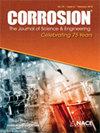乳酸铝和钼酸钠对碳钢辐照淡水腐蚀的协同作用
IF 1.3
4区 材料科学
Q4 MATERIALS SCIENCE, MULTIDISCIPLINARY
引用次数: 0
摘要
在本研究中,研究了一种适用于福岛第一核电站一次安全壳的缓蚀剂。考虑到初级安全壳的内部环境,缓蚀剂应能抑制碳钢在辐照下的淡水腐蚀,不应达到日本的排放标准。本文以乳酸铝和钼酸钠为原料,设计了一种符合上述条件的缓蚀剂,并对其腐蚀机理进行了研究。结果表明,0.75 mM的乳酸铝和0.25 mM的钼酸钠对碳钢的缓蚀效果最好。由于乳酸铝作为金属材料的缓蚀剂尚未见报道,因此本研究可以开发乳酸铝作为一种新型缓蚀剂。在200 Gyh−1的γ射线照射下,缓蚀剂仍能抑制碳钢的淡水腐蚀。溶液中的铝和钼酸盐离子在碳钢表面形成金属阳离子层,缺陷少,不含铁。该金属阳离子层既抑制了阴极氧还原反应,又抑制了阳极铁溶解反应,从而增强了碳钢在淡水中的防腐能力。本文章由计算机程序翻译,如有差异,请以英文原文为准。
Synergistic effect of aluminum lactate and sodium molybdate on freshwater corrosion of carbon steel under irradiation
ABSTRACT In this study, a corrosion inhibitor suitable for the corrosion inhibition of primary containment vessels at the Fukushima Daiichi Nuclear Power Station is investigated. Considering the internal environment of the primary containment vessels, the corrosion inhibitor should inhibit the freshwater corrosion of carbon steel under irradiation and should not come under effluent standards in Japan. Herein, a corrosion inhibitor was devised by combining Al lactate and Na molybdate that met the above conditions and its corrosion mechanism was investigated. It was found that 0.75 mM Al lactate and 0.25 mM Na molybdate were the most inhibitive to the corrosion of carbon steel. Since Al lactate has never been reported as a corrosion inhibitor for metallic materials, it could be developed as a novel corrosion inhibitor in this study. The corrosion inhibitor inhibited the freshwater corrosion of carbon steel even under gamma irradiation of 200 Gyh−1. Al and molybdate ions in the solution formed a metal cation layer on carbon steel with few defects and without iron. This metal cation layer inhibited both the cathodic oxygen reduction reaction and the anodic iron dissolving reaction, thereby enhancing the corrosion protection of carbon steel in freshwater.
求助全文
通过发布文献求助,成功后即可免费获取论文全文。
去求助
来源期刊

Corrosion
MATERIALS SCIENCE, MULTIDISCIPLINARY-METALLURGY & METALLURGICAL ENGINEERING
CiteScore
2.80
自引率
12.50%
发文量
97
审稿时长
3 months
期刊介绍:
CORROSION is the premier research journal featuring peer-reviewed technical articles from the world’s top researchers and provides a permanent record of progress in the science and technology of corrosion prevention and control. The scope of the journal includes the latest developments in areas of corrosion metallurgy, mechanisms, predictors, cracking (sulfide stress, stress corrosion, hydrogen-induced), passivation, and CO2 corrosion.
70+ years and over 7,100 peer-reviewed articles with advances in corrosion science and engineering have been published in CORROSION. The journal publishes seven article types – original articles, invited critical reviews, technical notes, corrosion communications fast-tracked for rapid publication, special research topic issues, research letters of yearly annual conference student poster sessions, and scientific investigations of field corrosion processes. CORROSION, the Journal of Science and Engineering, serves as an important communication platform for academics, researchers, technical libraries, and universities.
Articles considered for CORROSION should have significant permanent value and should accomplish at least one of the following objectives:
• Contribute awareness of corrosion phenomena,
• Advance understanding of fundamental process, and/or
• Further the knowledge of techniques and practices used to reduce corrosion.
 求助内容:
求助内容: 应助结果提醒方式:
应助结果提醒方式:


